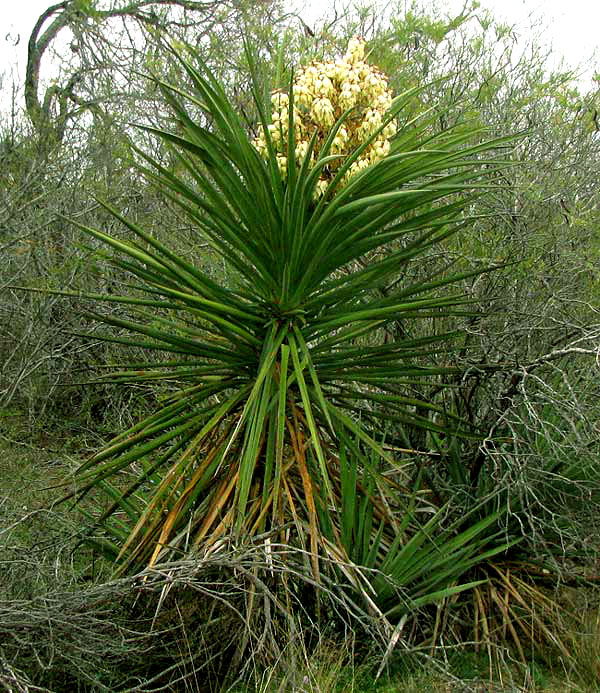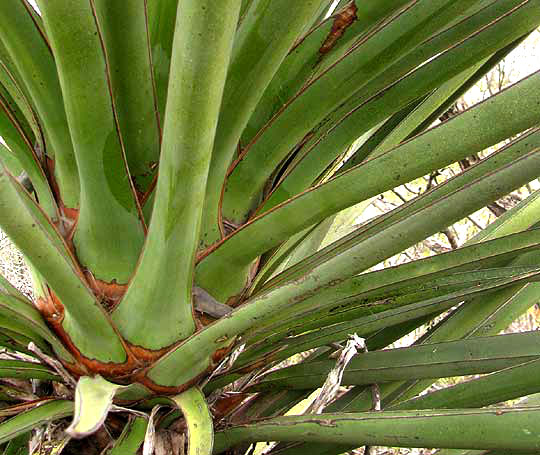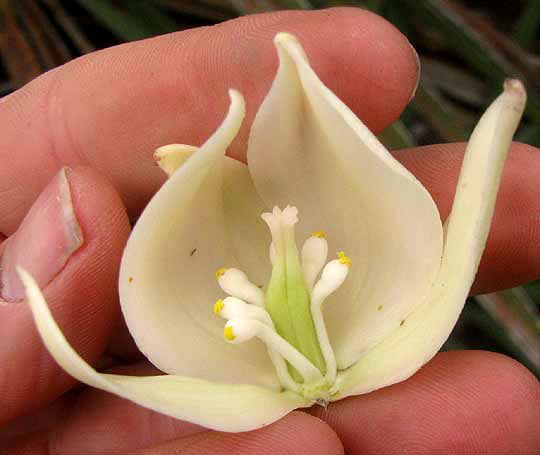Excerpts from Jim Conrad's
Naturalist Newsletter

from the March 30, 2014 Newsletter issued from the Frio Canyon Nature Education Center in the valley of the Dry Frio River in northern Uvalde County, southwestern Texas, on the southern border of the Edwards Plateau; elevation ~1750m (~5750 ft); N29.62°, W99.86°; USA
SPANISH DAGGERS FLOWERING
Last Monday I slid my mountain bike into the back of neighbor Phred's truck and we headed to Uvalde 35 miles to the south, and 781 feet (238m) lower in elevation, where I was let out, and began biking back north to Juniper House. Spring down there is far in advance of what it is at our higher and more drought-stricken elevation. In the scrub forest along US 83 as I pedaled north, the most spectacularly flowering plant was the yucca shown above
Many yucca species produce their leaves in spiky tufts at ground level, so one good field mark for this species is that its leaves issue from a trunk, which would be easily visible if the lower dead leaves and brush were cleared away. Another good field mark is that the large panicle of flowers is nestled among upper leaves and not held well above the plant on a clearly visible stem, or peduncle. Also, the panicle itself is broad, almost spherical, instead of tall and slender. A closer look at how the stiff blades attach to the stem is shown below:

A look inside the flower showing six oddly shaped stamens appears below:

Seven or so yucca species are to be looked for in Uvalde County. Part of the uncertainty as to how many species we have is that the experts are in disagreement as to whether ours with trunks and roundish flower clusters, like the one in our picture, are represented by two species or one. The online Flora of North America, which I normally accept as the last word on what's what, lumps the two species, so if we accept the Flora's philosophy, our picture shows YUCCA TRECULEANA, which goes by such common names as Spanish Dagger, Spanish Bayonet, Trecul Yucca, Palma Pita, and Palma de Datil.
However, other experts, such as possibly most Texas botanists, and those advising the Wildflower.Org website, recognize Yucca torrei, usually known as the Torrey's Yucca. Shinners & Mahler's Illustrated Flora of North Central Texas recognizes both species, but admits that they hybridize. Based on descriptions, drawings and photographs, I can't be sure which species is in our photo, so I'm sticking with the Flora of North America, and filing this page under, Yucca treculeana. The name Spanish Dagger is applied to several species, some of them not even yuccas, but around here that seems to be what everyone calls our tall yuccas.
Yucca treculeana mostly occurs in arid northern Mexico, but it extends into the US in southern Arizona, southern New Mexico and southern Texas; the questionable Yucca torrei covers much of the same territory.
Whatever our plants' "true name," this is a spectacular species, one that when in bloom in an ocean of gray-brown, wintry scrub draws attention to itself like a candle in a dark room. Those big, white panicles seem to hover in the scrub, ghostlike, beautiful.